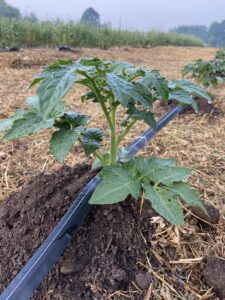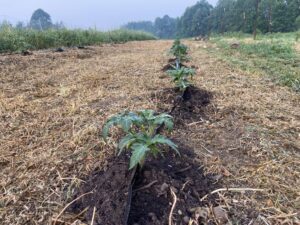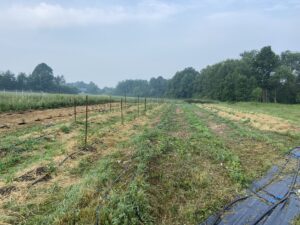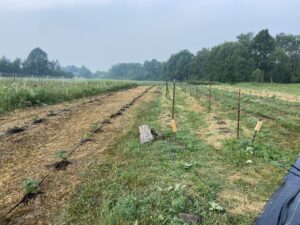Final report for FNC23-1381
Project Information
We have spent the past 4 seasons practicing regenerative agriculture for market gardening and livestock on 10 acres. In that time we transitioned to certified organic and expanded on certified organic practices and now we make all of our fertilizers, microbials, compost and foliar sprays to prevent disease all from sources on our farm. All of our foliar sprays and fertilizers are made from plant sources that are easy to grow and available throughout the season . We want to expand on our processes and quantify our methods so we can see if they can be scaled and used by other farmers to grow healthier food, facilitate soil health and be less reliant on synthetic and chemicals sprays. My role will be to coordinate the research and to develop the standard operating procedures for the project. We have tested this process for 2 seasons and have a procedures in place. The work will be conducted by myself and with the help of an employee of the farm.
Organic farming has limited resources for fungal disease prevention, and most options are either expensive or ineffective for treating fungal diseases. In my experience even the most costly solutions ($50+ per acre per application) provide limited results. We've tried a multitude of organic and natural options over the years with little effect on leaf septoria and other fungal diseases we've gotten on our plants. We want to create an option that other farmers can use that is cheap, robust and effective while also benefiting plant health and soil biology. In addition, all of the biological inputs needed for this project can be grown on a small area with limited capital investment.
Solution:
We will test the effectiveness of our herbal foliar applications. Our foliar spray will be made by aerating our herb mix (lemongrass, holy basil, stinging nettle, sage, bee balm, calendula and comfrey) for 24 hours. This is applied weekly / bi-weekly in conjunction with compost tea. In the past we have used this with great success to prevent disease and we want to quantify if this was luck or actually due to the application of the foliar solution.
The trial will be set up by creating raised beds with a mix of crops we've had difficulty with fungal infections in the past. The best candidate is tomatoes particularly those with later maturity dates. We will also consider using hemp plants due to their high rate of infection. We want to pick the crops that show the least natural resistance to fungal diseases.
Our trial will consist of at least 40 samples of each group for statistical significance. Our groups will be structure as follows:
Group 1: Control - no Foliar Application
Group 2: Foliar Application - herbal + compost tea 1-2 times per week
We will send in bi-weekly lab tests of both plant tissues samples and soil samples to see how these applications affect both the plant and soil health throughout the growing season. We will also notate and take pictures of the plants from week to week and record the presence of disease between the two sample groups.
Process overview:
- Gather herbs (~5lbs) and add to a 250 gallon tote of filtered water (if using compost tea the tea will brew for 24 hours prior to this using high quality compost). Use a gunny sack to keep the plant material contained
- Aerate the herbs for 24 hours
- Strain the solution and fill into sprayer tank
- Apply the solution with sprayer directly onto both the tops and bottoms of the plant leaves as well as the soil. This will be done early morning or evening. Repeat 1-2 times per week
- Bi-weekly gather samples for lab testing of both soil and plant tissue
Materials:
The materials required for this project are:
a) herbs - listed above grown in raised beds. For each brew the leaves are clipped with clippers
b) commercial scale sprayer applicator similar to what is used in chemical applications.
c) IBC tote with high output aerator
Sustainable Practices Used:
Organic / regenerative agriculture - If our process works we are revitalizing the soil while building the natural biology without the need for synthetic fungicides all while staying under the umbrella of certified organic practices.
Soil health - Our solution adds minerals and microbes back into the soil which should optimize our nutrient exchange capacity and indigenous microbes into the soil.
Objectives
- Quantify the effect of our solution on fungal disease - Does this process prevent disease?
- Quantify the effect of our solution on soil and plant health - Are our plants in a more optimum nutrient range with this solution? Is the brix content of the leaf material higher?
- Assess if this system is scalable and / or repeatable for other grows to use and optimize their operations.
- If successful - create educational videos or seminars to demonstrate how this system can be incorporated by others.
Research
Field Prep
We have an existing alfalfa field that was certified organic and managed by a local dairy farmer for the past four seasons as our growing location. We chose this field because we needed long rows to conduct our research. Each row was prepped by mounding the row then adding on a layer of 2 inches of compost. The plants were trellised using metal wire and fencing posts allowing us to tie the plant to the fencing post as it grew and to add more height layers to the fencing post as needed. We grew a determinate and an indeterminate variety. Our field was divided into three zones - biofungicide foliar application, fish hydrolysate application, and no application.
Early season prep - Drip irrigation with compost. Rows A and B were killed off with plastic cover for 3 weeks prior to planting:
Trellis system shown below with fencing posts and metal wire
Field Prep Thoughts:
Living mulch: Overall, the living mulch cover crop was not an ideal fit for this project. They alfalfa, even when consistently cut, crept into the new rows and choked out some of the tomato plants. Going forward we will use either paper or plastic to lay down around the plants to help with weed suppression and to reduce the number of hours spent on managing the crop. For our indeterminate varieties we used plastic to cover.
Varieties: We thought that the determinate variety would be the most consistent for the project, but we experienced a lot of plant predation. One of our rows was eaten by wild animals and livestock and was terminated part way through the project. They produced larger tomatoes but less of them and we found that they were attacked before the indeterminate variety and were not able to recover as easily. Going forward we will use safeguards against animals. We started with 20 of each variety per row. Each row had a zone dedicated to the growing practice. See attached spreadsheet for more details.
The indeterminate proved difficult to manage and trellis but were more resilient to predation.
Trellis: We used a fixed trellis with metal wires fixed to fence posts every foot. This method allowed for too much movement in the plants when trellised which caused the trellis to bend and break. This season we will use a Florida weave method to keep the plants more reliably fixed in place.
Irrigation: Two drip lines were placed on either side of the plant that ran down the length of each row. Rows were irrigated as needed but typically once per week prior to application.
Application: Applications were done with a commercial diaphragm pump sprayer unit to simulate doing this operation at scale and to avoid the set backs caused by smaller units that tend to clog and break.
Research & Data Gathering
Our primary goal was to reduce the fungal disease pressure we experience on our farm each year early to mid summer by applying our biofungicide made from aerating various herbs that are resistant to fungal disease in water for 12-24 hours, then applying a foliar spray to the plants early morning once per week. We collected brix readings every other application, tissue samples throughout the season and monthly soil samples to see how the nutrient uptake and health of the soil changed throughout the season. We also walked the fields to check the health of the plant and to see if there was any difference between our three groups (biofungicide, foliar application of fish hydrolysate and no application).
Due to the drought we experienced little to no disease pressure this year which is unusual. We had no noticeable plant damage due to disease on the plants. Disease pressure did not show up until later in the season once fruiting had already set in so we opted to use the yield from each group as a proxy for plant health. We will continue to do this going forward as well because we can capture additional data for how this system may affect yields.
See the attached spreadsheet for details on our research. We recorded soil samples, plant tissue samples, brix and plant yields.
Guide:
Zone 1 = foliar fed with biofungicide
Zone 2 = foliar fed with fish hydrolysate - this was done to parse out reduced disease pressure due purely to increased nutrients / plant health
Zone 3 = no foliar feed
We had four rows:
Row A - determinate variety - crop was terminated due to wildlife and livestock pressure
Row B - determinate variety
Row C - indeterminate variety
Row D - indeterminate variety
Each row had all three zones for each growing practice.
Attached below are our plant tissue tests and soil reports:
Soil Physical Analysis Report 7-21
Results:
Our main comparisons were plant health and plant yield. Due to the drought we had this past season we saw limited fungal pressure until late season so we used our tissue samples and total yield as a measure of plant health because there was little disease on the foliage. Normally we would have counted the incidents of fungal disease and the prevalence of it but since there was none until September we used other methods to proxy this data point. Overall, the plants with fish hydrolysate were slightly healthier than those with just the herbal aerated tea, which we expected because the tea should not have a significant level of nutrients. Our hydrolysate foliar applications were set to 1200ppm and the tea applications were not different from the water's existing ppm of ~200ppm.
Both test groups were still low in key nutrients even though they were present in the soil namely Phosphorus (P) & Potassium (K). We believe the drought might have killed off microbes that would help the plants uptake the nutrients. We confirmed with our soil consultant that used a microscope to confirm the lack of a complete microbe profile in the soil.
Our other metric was final yield by weight of each plant in each row + zone. We counted the number of tomatoes in each zone and row as well as the weight at each collection date (done weekly - bi-weekly).
We found that our herbal solution (Zone 1) had lower overall yield than the other two groups with an average weight of 150g per tomato and a total yield of ~140lbs from 61 plants compared to:
Zone 2: 154g per tomato, 204 lbs total
Zone 3: 124g per tomato, 157lbs per plant
Given that Zone 2 was substituted with fish hydrolysate we expected the higher yields from this group. We were surprised to see that Zone 3 outperformed Zone 1, but this could be due to a number of factors. It produced more tomatoes and was less manicured than Zone 1 due to frequent trellis breaks and thus each plant had more vines than Zone 1. There was also less pest pressure in Zone 3.
Going forward we will monitor this closely and see if we have the same results going forward. Our experiment calls for the usual disease pressure mid season so if we have similar conditions to this past season we will use these same proxies for fungal pressure. Our final success metric is seeing less plants with fungal pressure.
In addition, we recorded the BRIX on our plots which is a measure of sugar content in the leaf material which is considered a method to measure plant health. Overall, we saw slightly healthier plants in our herbal solution in rows C & D which were Roma tomatoes and better results from adding a nutrient foliar feed in rows A & B which was a determinate variety.
| Herbal Tea | Nutrients | Difference | |||||||||||||
| A | B | C | D | A | B | C | D | A | B | C | D | ||||
| Week 1 | 13 | 14 | 13 | 12 | 12 | 15 | 12 | 10 | 1 | -1 | 1 | 2 | |||
| Week 2 | 11 | 11 | 11 | 12 | 13 | 13 | 13 | 13 | -2 | -2 | -2 | -1 | |||
| Week 3 | 15 | 15 | 15 | 15 | |||||||||||
| Week 4 | |||||||||||||||
| Week 5 | 10 | 11 | 12 | 11 | 15 | 15 | 11 | 11 | -5 | -4 | 1 | 0 | |||
| Week 6 | 11 | 11 | 11 | 11 | 9 | 11 | 9 | 9 | 2 | 0 | 2 | 2 | |||
| Week 7 | 13 | 12 | 11 | 13 | 11 | 11 | 12 | 14 | 2 | 1 | -1 | -1 | |||
| average | -0.4 | -1.2 | 0.2 | 0.4 | |||||||||||
2024 Update:
We made some modifications to our test field in 2024. Our field had an existing stand of field grass and alfalfa that we planted directly into in 2023. The alfalfa required consistent maintenance and crowded out some of our tomato plants. For 2024 we tilled and laid rows of plastic mulch with drip tape irrigation.
We planned on using the same tomato varieties as the previous year but we purchased seed mix that did not have consistent germination and did not produce healthy seedlings so we had to buy tomato starts in 4in pots. Our field was comprised of on determinate variety instead of the split between two varieties like the previous year. In addition, we planted 45 plants per test group (herbal / biofungicide, foliar nutrient feed, and control). Due to high winds shortly after planting, we had a loss of ~30%+ in each group.
Data gathered for this year was; visual observation of plant disease, BRIX content of leaf material, and total yield per plant. Contrary to 2023, we did not do any soil or tissue samples. We researched plant tissue sampling and found issues with the testing methods so we opted to do a plant sap analysis but could not find a lab that could conduct the tests within our budget parameters.
Our visual results for plant disease did not yield a significant different between field zones:
Herbal: 1 instance of plant disease, 1 instance of fungal disease on leaf (minor)
Nutrient: 1 instance of minor disease on leaves
Control: 3 instance of plant disease (plants stunted or clearly affected)
Overall, the herbal biofungicide provided a slightly better result over the control and slightly worse than the nutrient foliar solution group. The similarity between groups might be due to the variety of tomato we planted. We had limited choices to replace our tomato seedlings that did not germinate and the only variety we could acquire in time that met our requirements for size and price was variety that had resistance to blight. Therefore, we believe the other metrics we recorded (BRIX & Yield) are more indicative as to whether the biofungicide is effective or not.
Results from BRIX testing (2024)
| BRIX Average Per Zone | |||||
| Week | Date | Herbal | Nutrients | Control | |
| Week 1 | 6/26 | 8 | 8 | 8 | |
| Week 2 | 7/2 | 8 | 8 | 8 | |
| Week 3 | 7/8 | 10.5 | 10 | 10 | |
| Week 4 | 7/15 | 11 | 11 | 11 | |
| Week 5 | 7/24 | 16 | 14 | 14 | |
| Week 6 | 7/31 | 16 | 11 | 13.5 | |
| Week 7 | 8-7 | 14 | 13.5 | 12.5 | |
| Week 8 | 8-14 | 13 | 13 | 12 | |
| Week 9 | 8-22 | 13.5 | 12.5 | 14 | |
| Average | 12.2 | 11.2 | 11.4 | ||
This season we saw a slight difference between the herbal foliar (biofungicide) and the other two groups. This was due to a significant increase in BRIX once the plants established themselves and started to transition to fruit, which is also the same time we see the first signs of blight. If we tested this idea further we would like to see if we can achieve the same results by spraying only during critical times in the growing season instead of every week.
Yield Results 2024:
| Herbal | Nutrient | Control | |
| Grand Totals (g) | 152,100 | 177,544 | 136,183 |
| Grand Totals (lbs) | 335.02 | 391.07 | 299.96 |
| Lbs / Plant | 10.15 | 11.85 | 7.69 |
| Additonal Costs | $10 | $259.99 | 0 |
| Per Plant | $0.30 | $7.88 | $0.00 |
| Not Including Labor | |||
| Additional Yeild in lbs | 2.46 | 4.16 | 0 |
| Over Control | |||
| Cost Per Additional Lb | $0.12 | $1.89 | |
The critical data from this chart is the total yield per plant and the cost associated with that yield. The biofungicide group yielded ~32% more per plant compared to the control group. We estimated the cost for the biofungicide to be $10, which is about the cost for the seeds for the herbal mix we used, however this amount could vary and is more likely to be $0 once the herbs are established as most either seed themselves for the following season or are perennial.
We purchased Advancing Eco Ag nutrients for the nutrient group which mirrored the deficits we saw in the plant tissue samples from the previous year. This nutrient mix sprayed at weekly intervals yielded a 54% increase over the control group and a 14% increase over the biofungicide group for a cost of ~$260. This figure is high due to the number of applications but just like the biofungicide group, these sprays can probably be toned down to match the key growth points in the plants lifecycle. In addition, a plant sap analysis will make it easier to tune a foliar feed so there is less wasted spray or applications of unneeded minerals and fertilizers. None of these figures account for labor or other variable expenses due. These figures will vary by operation and will be significantly lower than our research if there are minimum spraying events.
Is the yield worth the cost? That depends on the price of tomatos, but the herbal solution offers a great increase in yield with minimal cost in supplies.
Differences from 2023:
The primary driver for lower yield for the control group in 2024 as compared to 2023 is due to cleaner trellising. Our control group in 2023 was trellised later which allowed for the plants to bush out and produce more fruiting sites. With equal trellising and a more manageable field with the plastic mulch, we had more accurate results in 2024.
Our final tomato counter per zone:
herbal: 33
nutrient: 33
control: 39
Conclusions:
Overall, we see the biofungicide as a potential way to increase yield and reduce disease. Based on the results we see the best way to for growers to implement this into their practices is to combine the nutrient foliar spray (spray composition informed by plant sap analysis) with the herbal foliar spray at key times during the plants growing cycle. We also saw lower incidence of plant disease vs the control group so there is an additional cost savings in reducing loss of yield.
Educational & Outreach Activities
Participation Summary:
Outreach:
We are working with the South Dakota Specialty Producers (SDSPA) which aims to educate specialty producers. We are conducting zoom conferences throughout the spring and presenting on our topic and findings thus far.
We did weekly farm tours with our farmers market customers and other farm vendors. We also consulted with some existing growers regarding our biofungicide and plan to do multiple demonstrations this coming season.
We are actively networking and meeting with other growers (particularly produce) so we can conduct field day demonstrations throughout the season. In addition, we shot a video (still being edited) with a professional videographer to use as an educational resource. This was done as a favor by the videographer.
Lastly, we teamed up with a Soil Food Web consultant to help us better understand the mechanisms at play and quantify our results. We will incorporate that into our live demonstrations.
Update 2024:
We conducted a field day demonstration with the Garden Masters of Washington County and showed our process for the project, shared preliminary findings and showed a group of 15 how they can make their own herbal foliar spray to help prevent disease in the garden or on their farm.
We also conducted farm tours and demonstrations to our existing customers and to other local farms. We conduct tours on the weekends and week nights and typically had between 1 and 2 tours per week with the focal point being education on the project.
Learning Outcomes
Our main take away is the variability from season to season. Our project is geared towards seasons with high disease pressure that is created in a humid and moist environment. As this past season has shown, there will be seasons were our biofungicide is not applicable or needed especially when we have seasons with long stretches of drought like we did this past year.
In addition we learned some techniques to fine tune our testing. We wanted to keep our project a simple as possible and refrain from using any non-organic inputs or excessive row cover like plastic (will change year 2). This season we plan to use plastic row cover with mulch to suppress our field grasses and perennial row cover from overtake any plants.
For testing purposes we have seen the limitations of plant tissue analysis and plan to use sap analysis this year to get a better sense of nutrient uptake by the plants.
Update 2024:
Our takeaways for the projects second year was that there are key points in the plants growing cycle where the plant uptakes the most nutrients (late veg / early fruiting) and other points where it is most vulnerable to disease (early & late fruiting).
Overall the biofungicide seems like a cost effective way to reduce disease and we believe we can see more consistent results by managing the nutrient intake of the plants with a foliar spray combined with the biofungicide at key points in the plants growth cycle and disease pressure cycle.
Lastly, we learned that there is variability between varieties. We saw similar disease pressure in a good year as we did in the bad year with varieties that were naturally resistant to blight, which we planted in year 2 out of necessity as outlined earlier in the project study.



